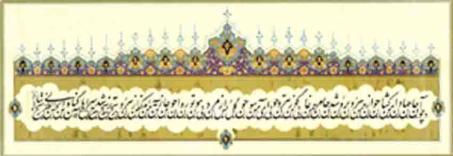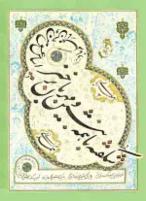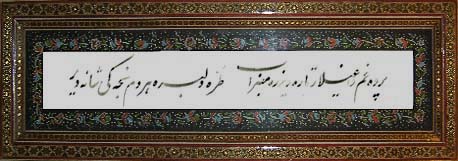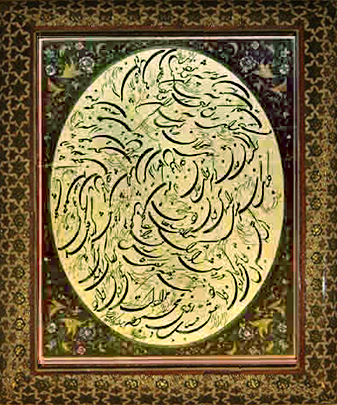Making a Beautiful Persian Calligraphy Master Piece is a Teamwork!
In this section, a few other Persian arts will be introduced as these arts have been accompanying Persian Calligraphy master pieces throughout the centuries beautifying them to the highest point. These arts are Decorative Border Painting (Taz’heeb), and Conglomerate Framing (Khaatam).
DECORATIVE BORDER PAINTING (TAZ’HEEB)
Great Persian calligraphy masters have been always working hand-in-hand with great Taz’heeb artists. Calligraphy master pieces have been traditionally decorated with fine paintings around them. Once Persian calligraphy artist is finished with his calligraphy piece, Taz’heeb painter takes over and decorates the master piece. He draws beautiful geometrical patterns and/or fine miniature paintings around the calligraphed words. Taz’heeb usually extends from inside to the outside of the art work where it makes a rectangular, circular, or oval shape border around the calligraphy piece.

Taz'heeb or Decorative Border Painting
Taz’heeb painter has to follow certain rules as his art should match with the style, form, and also meanings of calligraphed words as they together represent and depict the meanings of the poem or verse that they hold.
Among contemporary Taz’heeb artists, "Mohammad Tariqati" is the most prominent figures.

Another Example for Taz'heeb or Decorative Border Painting
CONGLOMERATE FRAMING (KHAATAM):
Traditional conglomerate framing has a long history behind it. It is one of the most beautiful styles of framing and certainly one of the most complicated methods.

Conglomerate Framing (Khaatam)
The process of making a conglomerate frame is consisting of the following steps:
First of all, Khaatam artist designs his envisioned geometric pattern. This pattern is normally a combination of tiny triangular, rectangular, or hexagonal shapes next to each other that usually create a symmetrical form.
Then, long prisms with tiny cross-sections of the same shapes are made. These prisms are almost 1/16" tick and 10"-12" long. They might be made of camel-bone, hard-wood, goat horn, traditional metals, and so on.
Next step is to put these long stripes next to each other following the designed pattern mentioned in the step one; and glue and compress them to each other. It makes a rigid conglomerate of prism strips.
Finally, Khaatam artist cuts thin cross-sections of this conglomerate and pastes them on the bare wooden frame he has made before. After final finishing the Conglomerate Khaatam Frame is ready.

Conglomerate Framing (Khaatam)